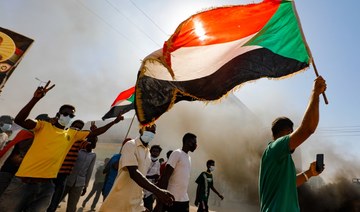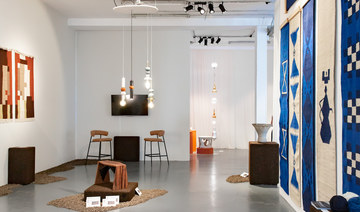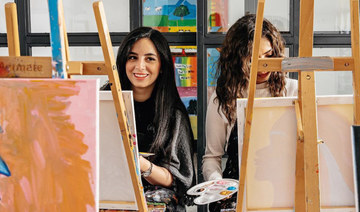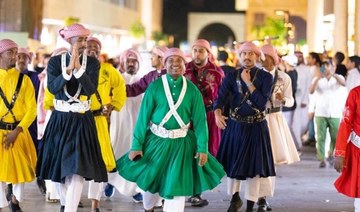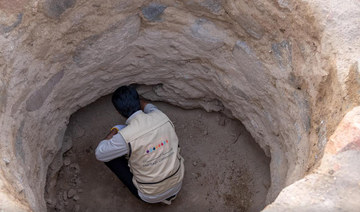CAIRO: Nearly two years after the overthrow of autocrat Omar Bashir, Sudan is taking steps to rejoin the international community from which it was long shunned. That includes its film industry.
For the first time in its history, Sudan has a submission for the Academy Awards. Produced by a consortium of European and Egyptian companies but with a Sudanese director and cast, “You Will Die at Twenty” will compete in the Best International Feature Film category.
The story follows a young man whose death at the age of 20 is prophesied not long after his birth, casting a shadow over his formative years, and parallels the burdens placed on a generation of Sudan’s young people.
Based on a short story by Sudanese novelist Hammour Ziyada, critics say it demonstrates that the country’s cultural scene is reawakening after decades of oppression.
The film was produced amid mass demonstrations against Bashir, who was toppled by the military in April 2019 after ruling the country for nearly 30 years.
“It was an adventure,” filmmaker Amjad Abu Alala told The Associated Press. “There were protests in the streets that had grown to a revolution by the beginning of filming.”
Sudan’s uprising erupted in late 2018, and as the number of people in the streets swelled, many of them young, the military stepped in and toppled the Islamist president. Since then, the country has embarked on a fragile transition to democracy, ending years of theocratic rule that limited artists’ freedoms.
The film’s submission was announced in November by the country’s ministry of culture, a month before the second anniversary of the start of the uprising.
It follows a narrative written by Ziyada in the early 2000s that chronicles the life of a child in 1960s in a remote village, located between the Blue and White Nile rivers. The inhabitants are largely guided by ancient Sufi beliefs and traditions, a mystical strain of Islam.
The film starts when a mother, Sakina, takes her newborn boy to a Sufi ceremony at a nearby shrine as a blessing. As a sheikh gives his blessing, a man in traditional clothing performs a meditative dance, suddenly stopping after 20 turns, falling to the ground — a bad omen.
The frightened mother appeals to the Sheikh to give an explanation. But he says, “God’s command is inevitable.” At this point, the crowd understands this is a prophecy predicting the child will die at 20.
Stunned and frustrated, the father leaves his wife and son, named Muzamil, to face their fate alone.
Muzamil grows up under the watchful eye of his overprotective mother, who wears black in anticipation of his early demise. He is haunted by the prophecy — even other children name him “the son of death.”
Despite that, Muzamil proves to be an inquisitive boy full of life. His mother allows him to go to study the Qur’an. He receives praise for his memorization and recitation of verses. Then comes a turning point.
A cinematographer, Suliman, returns to the village after years working abroad. Muzamil, who is by now working as an assistant to the village shopkeeper, gets to know him through delivering him alcohol, a social taboo.
Suliman, who lives with a prostitute, opens Muzamil’s eyes to the outside world. Through their discussions, he starts to doubt the prophecy that has governed his life so far and torn his family apart.
As he turns 19, Muzamil takes it upon himself to decide what it means to be alive, even as death beckons.
The film has received positive reviews from international critics. It premiered at the 2019 Venice International Film Festival’s parallel section, Venice Days. It won the Lion of the Future for Best First Feature — the first Sudanese film to do so. Since then, it has won at least two dozen awards at film festivals worldwide.
Abu Alala says his team tackled obstacles in making the film, thrown up by the same conservative milieu that it depicts. He blames the environment created by Bashir, who came to power in a military coup in 1989. Under his rule, limited personal freedoms meant art was viewed with suspicion by many.
One major challenge, he said, was that local residents at the initial filming location objected to their presence. The crew was forced to move, but they persevered.
“We believed that it should be done under any circumstances,” Abu Alala said. He says that it was lucky that the film’s production period coincided with the cultural watershed moment of the uprising. The previous government wouldn’t have been a proponent of his work.
The movie has also been met with commendations from inside the region.
“It is a very real and local film that makes the audience feel all of its details whenever and whoever they are,” wrote Egyptian film critic Tarik el-Shenawy.
The film is only the eighth to be made inside Sudan. Abu Alala says that its selection shows Sudan has countless stories that remain untold.
“There wasn’t a film industry existing in Sudan — only individual attempts ... Sudan’s rulers — communists or Islamists — were not interested in cinema. They just were interested in having artists on their sides,” he said.
Now, he hopes that he and other filmmakers will have the freedom to share Sudan’s stories with the world.
A Sudan in transition presents first-ever film for Oscars
https://arab.news/w9dvs
A Sudan in transition presents first-ever film for Oscars
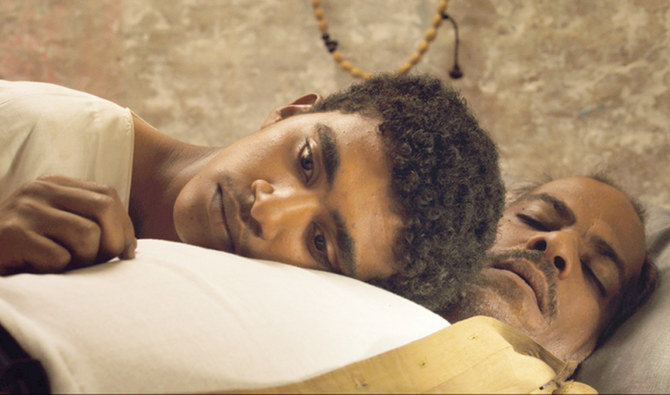
- Muzamil grows up under the watchful eye of his overprotective mother, who wears black in anticipation of his early demise. He is haunted by the prophecy — even other children name him “the son of death”
Artist Dalya Moumina: ‘Jeddah is always going to be home to me’
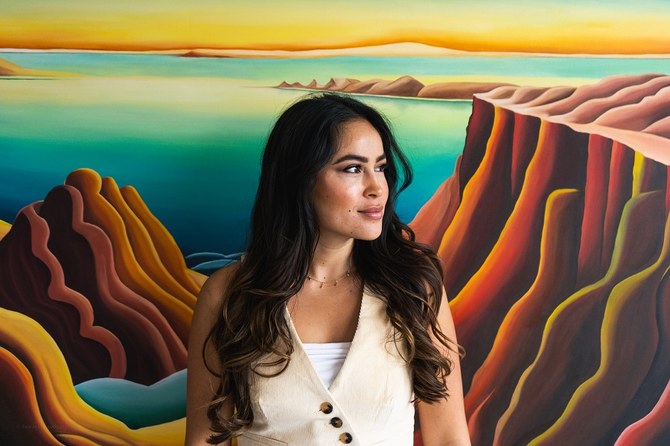
- The NYC-based Saudi-Filipina artist discusses growing up in the Kingdom and how her cultural background has influenced her work
DUBAI: Dalya Moumina is an emerging New York-based artist whose imaginative landscape paintings partially pay tribute to her Arab and Asian heritage. She was born in Washington DC in 1996 to a Saudi-Palestinian father and a Filipina mother. Both were travel lovers, who luckily happened to have met each other on a flight. When Moumina was three years old, her family relocated to Saudi Arabia.
“Jeddah is always going to be home to me. Whenever I go back, it feels like I never left,” Moumina tells Arab News. “Growing up there was very adventurous. I lived the Jeddah lifestyle, right on the Red Sea, which was the best childhood to be honest. I’d go to the beach almost every weekend and we would do desert trips and hiking. I was also a professional horseback rider. I think the part of Jeddah that most influences me is definitely the water. The Red Sea is, in my opinion, the most beautiful sea out there. It’s so blue.”
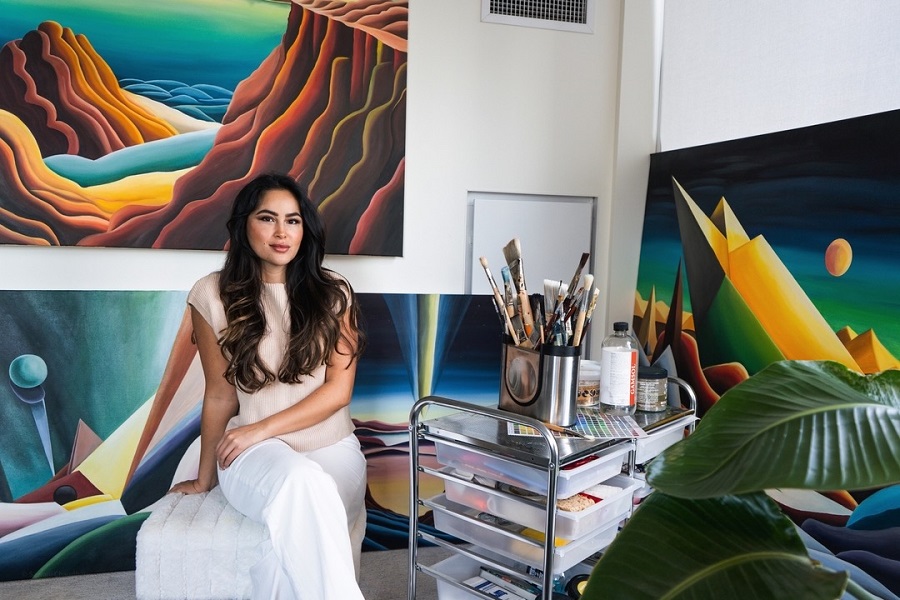
She also has a special connection with the Philippines, which she visited every summer when growing up. “I’d see my mother’s side of the family and my cousins. The people are so kind-hearted. We would go to the islands there, like Boracay and Palawan. They’re absolutely stunning,” she says. “I think I try to bring those influences into my work, especially the tribal communities there. For example, in ceremonies, they’re very into face painting primitive shapes that symbolize different things.”
Those childhood memories have seeped into the bold utopian landscape imagery that Moumina started creating in 2019.
“We have volcanoes and beautiful islands in the Philippines. I think growing up around those extreme and contrasting landscapes led me to amalgamate them into my work, because the meandering, like, rivers and labyrinthine terrains there are unlike any other place, in my opinion — contrasting with the desert landscapes in Saudi Arabia,” she explains.
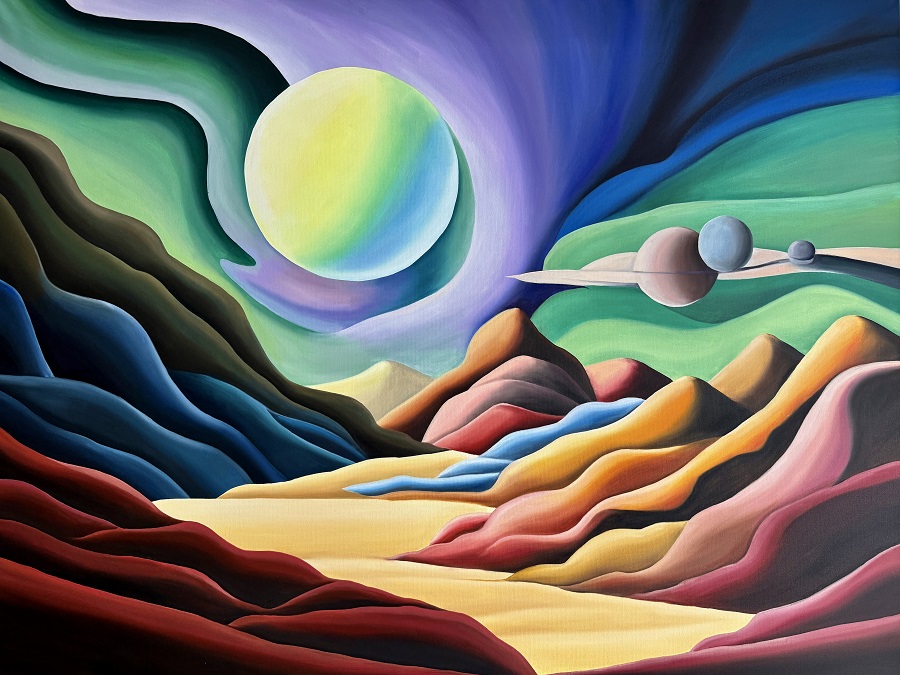
Although she doesn’t come from an artistic family, Moumina always found herself making collages, scrapbooking and drawing.
“I’ve been painting my whole life. I never took it seriously, but I think it was always an innate part of me,” she says. She also had an aunt who drew and she encouraged her niece. During high school, Moumina took art classes and actually sold her first artwork at a school exhibition.
She later attended the University of Virginia to study business, technology and psychology (along with a few art classes). It was while in Virginia that she discovered the work of American master Georgia O’Keeffe, who famously depicted America’s sweeping mountainous landscapes.
“She used to teach at my university, and she’s such a big inspiration in my work,” says Moumina. “I would say that our styles are similar, but, obviously, I’m trying to distinguish myself.”
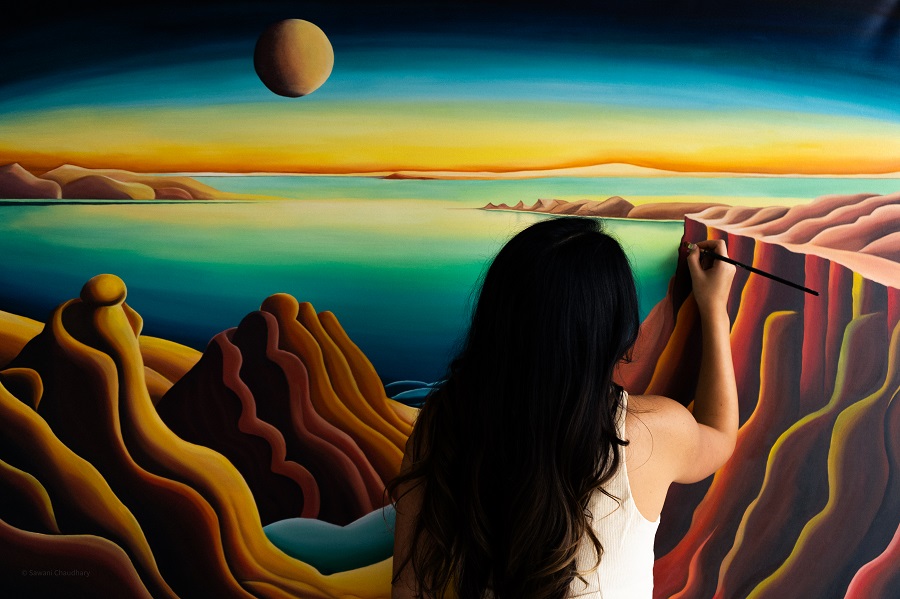
In 2019, Moumina graduated, but a few months later the COVID-19 pandemic hit. She started painting again during lockdowns.
“I really missed traveling, so I was thinking of the landscapes and the ocean from Saudi and the feeling of being by the beach,” she says. “I’ve always loved using oil paint, because it’s slow-drying and the colors are so rich. It’s very therapeutic and relaxing. Sometimes, I’ll play melodic music, other times I’ll work in silence. Whenever I start painting, I just go into a flow state of mind and work for hours — forgetting to eat. You don’t even realize it.”
Moumina’s arresting landscapes feel otherworldly, isolated and fantasy-like. At times, a large yellow sun dominates the composition, above wave-like mountains and flowing rivers. Inspired by cubism and surrealism, Moumina executes her paintings in three-dimensions, with sharp contrasts and bold colors.
“Each piece, I’d say, has a distinctive energy and character,” she says. “I don’t want people to just look at the work, I want them to feel something and walk away thinking about it more, and thinking something new. I try to lure people in through the energizing presence of fresh possibilities. . . I hope people see, through my work, that everything is simply interconnected and interactive.”

Along with the vivid colors and energy in Moumina’s work, there is also a sense of somberness. “There’s so much happening in the world,” she says. “I think of my grandmother, who was Palestinian. She was evicted from her home back in the Forties, and I made a painting that was inspired by her. Because I live all the way in New York, it’s kind of hard to keep in touch with what’s happening in the Middle East.”
Moumina has been living in New York — which she describes as “the art capital of the world” — for two years, and she is represented by GR Gallery. On May 3, a group show, “Transfiguration,” opened at the gallery. The show includes a selection of Moumina’s nature pieces. She says that being an artist in a well-established art scene like New York is competitive, and that she has considered doing a Master’s degree in art, but she realized that she needed something more in order to succeed.
“What helps you in this industry is networking and not staying in your studio 24/7,” says Moumina, who describes herself as sociable and extroverted. “Half of it is also connecting with other artists and really putting yourself out there.”
She also believes that being both Saudi and a woman has been an advantage so far in her career. “I think it’s still a male-dominated field,” she says. “But a lot of gallery owners are trying to bring up more female artists, because that’s what’s kind of in demand nowadays.”
Qatar highlights Arab, South Asian and African films at the Venice Biennale
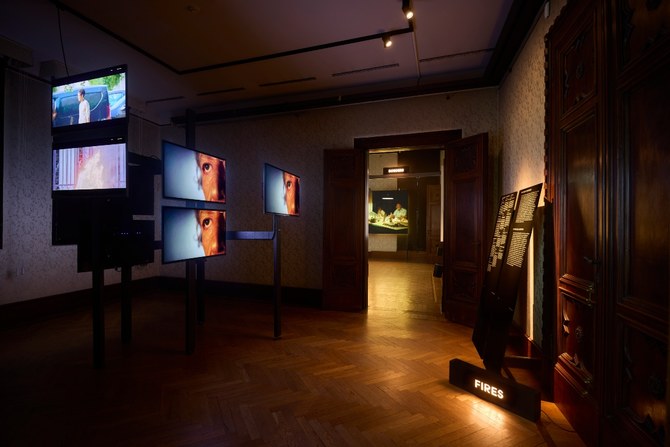
- Highlights include Ali Cherri’s “The Dam” (2022), charting the story of a Darfuri seasonal worker from Sudan
VENICE: For its second showing during the Venice Biennale, Qatar is staging the exhibition “Your Ghosts Are Mine: Expanded Cinemas, Amplified Voices” that takes a profound, in-depth look at the last decade of film and video art by Arab, South Asian and African filmmakers.
While Qatar has yet to have its own national pavilion, its exhibition occupies the 459-year-old Palazzo Cavalli-Franchetti on the Grand Canal. The works on show are drawn from the collections of Mathaf: Arab Museum of Contemporary Art, the Doha Film Institute and the forthcoming Art Mill Museum (scheduled to open in 2030). It is divided into ten galleries, each comprising films and video art according to a specific theme such as ruins, women’s voices, borders, exile and deserts and is curated by Paris-based Matthieu Orlean, a film and video expert. The exhibition will run until November 2024.
“Film is very relevant to our institutions and is an important part of our collections,” Zeina Arida, Director of Mathaf: Arab Museum of Modern Arab Art in Doha, told Arab News.
“It is a great way to document our contemporary times,” she added. “Film is also a great way of to share who we are and what we are going through, what we as societies from these less represented countries are living and the issues we are facing.”

In-depth storytelling can be found in the films on view by Shirin Neshat and Shoja Azari, Larissa Sansour, Fares Fayyad, Ali Cherri, Shaima Al-Tamimi, Ramata-Toulaye Sy, Hassan Khan and Sophia Al-Maria, among others.
In a documentary and largely journalistic style, many of the works shed light on current events and issues not often covered in mainstream media, including the now one-year old conflict in Sudan or migrants seeking new homes such as those captured in the film by Yemeni East African filmmaker Shaima Al-Tamini who charted the journey of her family from Kenya and Zanibar to the UAE.

“I was looking at movies that were different from the rest — that take a risk of telling their own story in a specific way,” curator Orlean told Arab News. “The filmmakers of these films are foreigners in their own environment because they are capturing events, whether personal or collective, that many people don’t see even in the news. Many deal with the themes of migration, social differences and exile.”
The works on view showcase both long and short films. A few highlights include Ali Cherri’s “The Dam” (2022), charting the story of a Darfuri seasonal worker from Sudan who works during the night to create a mud-brick monument. The film is a political fable that tells of the power of imagination against the backdrop of the Sudanese revolution. There is also Qatari artist Sophia Al-Maria’s well-known work “Black Friday” (2016) and British-born Egyptian multimedia artist Hassan Khan’s “Jewel” (2010) featuring a luminescent fish in dark waters followed by two men dancing to Arabic music.
“‘Jewel’ was triggered by a moment witnessed on the street in Cairo in 2006 — two men dancing around a speaker with raw, brutal and beautiful music blaring out,” Khan told Arab News. “It took four years before I could finally produce the work for Mathaf's opening exhibition in 2010 and by then so much was bubbling around us that it seemed to channel something real. Imagine a one second flickering daydream slowed down and stretched into six intense minutes. It is about our deepest sources — history, culture, emotion — and how we communicate the alien that lives inside all of us.”
Saudi Music Commission hosts open meeting on preserving national musical heritage
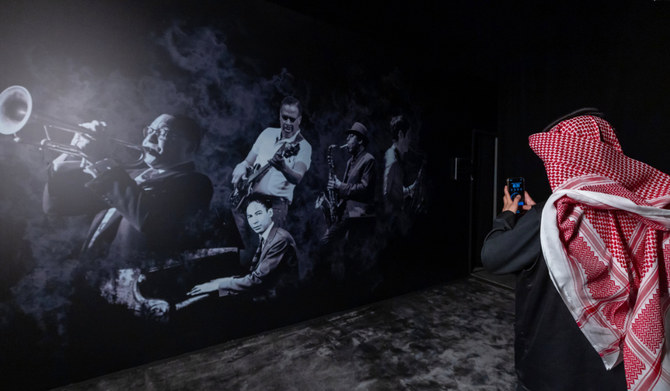
- The meeting highlighted the achievements of the Saudi Music Memory initiative, which secured rights for over 5,000 works, documented 305 musical notations, and produced two musical notation books
RIYADH: The Music Commission hosted an open meeting on the Saudi Music Memory initiative, engaging with music enthusiasts and industry professionals, the Saudi Press Agency reported on Tuesday.
The goal was to involve them in preserving the Kingdom’s musical heritage, as part of a series of open meetings designed to keep the musical community informed and encourage their participation in documenting and preserving Saudi music.
The virtual meeting outlined the initiative’s focus on documenting music and lyrics composed by Saudi artists through the mid-1980s, aiming to preserve and archive these works and the evolution of the Saudi music scene.
The meeting highlighted the achievements of the Saudi Music Memory initiative, which secured rights for over 5,000 works, documented 305 musical notations, and produced two musical notation books. The first book, titled “From the Memory of National Songs,” was released to coincide with this year’s Founding Day. The second book, “From the Memory of Ramadan Songs,” is completed and set to be published before Ramadan 2025.
The meeting featured interviews with renowned artists who experienced the early days of Saudi music, like Mohammed Abdu, Abadi Al-Johar, and Jamil Mahmoud, who shared stories about the origins of Saudi music and the role of its pioneers.
The meeting outlined the stages of the initiative, beginning with securing the rights to use classical musical and lyrical works, which has been completed. The second stage, transcribing musical works, is underway. Next, the commission plans to create documentary content and reproduce and distribute significant musical works, expected to be completed in the upcoming year. Once these stages are finished, the final step will be building an integrated platform.
The commission adhered to a scientific methodology, ensuring honesty and neutrality in all outputs of the initiative. It eliminated community and private artistic biases, aligned with the Saudi Cultural Memory Center, followed the guidelines in the documentation and digital archiving manual issued by the Ministry of Culture, and conducted a comprehensive inventory of all relevant materials and information.
The commission launched the Saudi Music Memory initiative to document the history of Saudi art, aiming to create a reliable reference, highlight its regional influence, offer academically documented research for musicians, researchers, and interested parties, and showcase high-value musical works that have not received due media attention, the SPA reported.
Macklemore shares teaser for new song in support of Gazans

DUBAI: American rapper Macklemore is set to release a new song this week in support of Palestine.
Titled “Hind’s Hall,” the track honors Hind Rajab, the 6-year-old Palestinian girl who was killed by Israeli soldiers in Gaza while waiting to be rescued.
Drawing its inspiration from the global student protests, the singer released a teaser of the track on his Instagram feed and said that all proceeds from its sale would be donated to UNRWA.
“The people, they won’t leave / What is threatening about divesting and wanting peace? / The problem isn’t the protests, it’s what they’re protesting / It goes against what our country is funding / Block the barricade until Palestine is free,” he sings.
“What you willing to risk? / What you willing to give? / What if you were in Gaza? / What if those were your kids? You’d want the world to stand up / And the students finally did.”
The full song has yet to be released on streaming platforms.
Saudi Heritage Commission event celebrates ancient Rakah
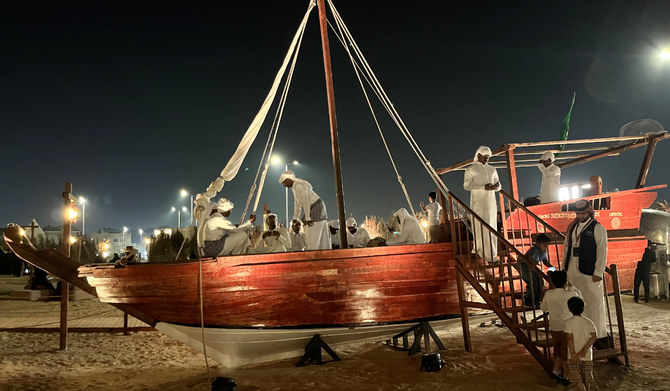
- “We want our customers to enter our space, either in our booth at the event this week or our studio location, and in just a short time be able to produce something customized to take home, she told Arab News
DAMMAM: The Heritage Commission is holding an event to celebrate ancient Rakah, with historical reenactments, guided tours, archaeological experts and handicrafts.
Once a major trading spot, some 1,500 years ago, the area takes its name from an indigenous tree species that once flourished there. The sandy environment was also once under the sea and shells can be found still glued to the rocks.
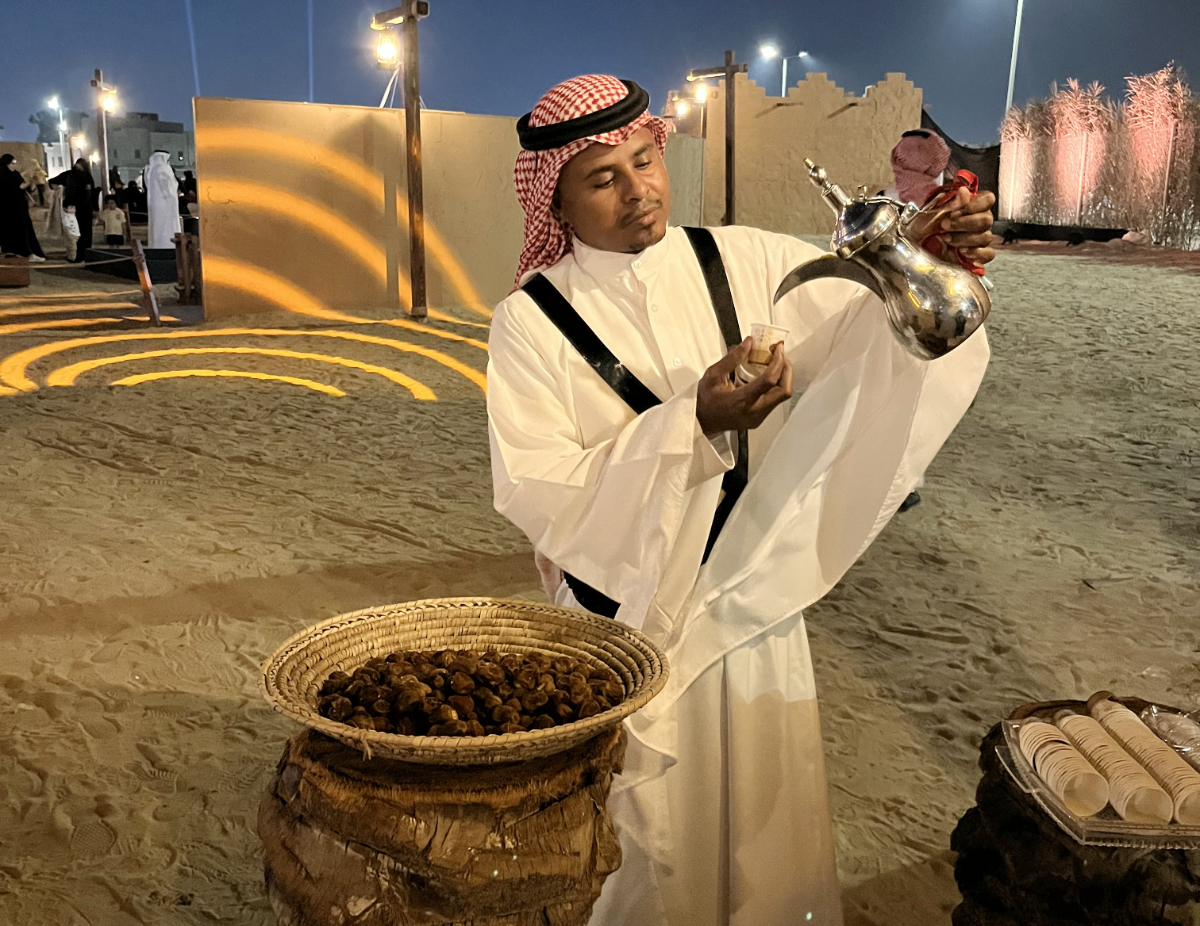
Many of the guides are female archaeology graduates from Imam Abdulrahman Bin Faisal University, formerly known as the University of Dammam.
Wala Al-Nafaiai, who co-founded Dam Studio, a local business that specializes in handmade goods made of cow and camel hide, said she was looking forward to showing off her products to visitors.
FASTFACTS
● Once a major trading spot, some 1,500 years ago, the Rakah area in Dammam takes its name from an indigenous tree species that once flourished there.
● The sandy environment was also once under the sea and shells can be found still glued to the rocks.
“We want our customers to enter our space, either in our booth at the event this week or our studio location, and in just a short time be able to produce something customized to take home, she told Arab News.

“Instead of going to a restaurant, we want you to spend the time to have an experience, produce something practical and learn skills you can utilize later.”
Al-Nafaiai said she was delighted with how many people had taken part in the workshops she provided at her booth.
It seems many (people) enjoy customizing something that they feel connected to once they make it with their own hands.
Wala Al-Nafaiai, Dam Studio co-founder
“It was so crowded … I was surprised that there were more adults than children who wanted to join in, although the craft was very simple,” she said.
“It seems many (people) enjoy customizing something that they feel connected to once they make it with their own hands. And that is our goal and the goal of the Heritage Commission who invited us to join this successful event.”

Visitors were also able to learn about the importance of dates to the community in ancient times and how local people would make and trade date syrup with visiting merchants.
Organized in cooperation with the Sharqiya Development Authority, the festival ends on Tuesday. For more information, visit heritage.moc.gov.sa or @mocheritage.



